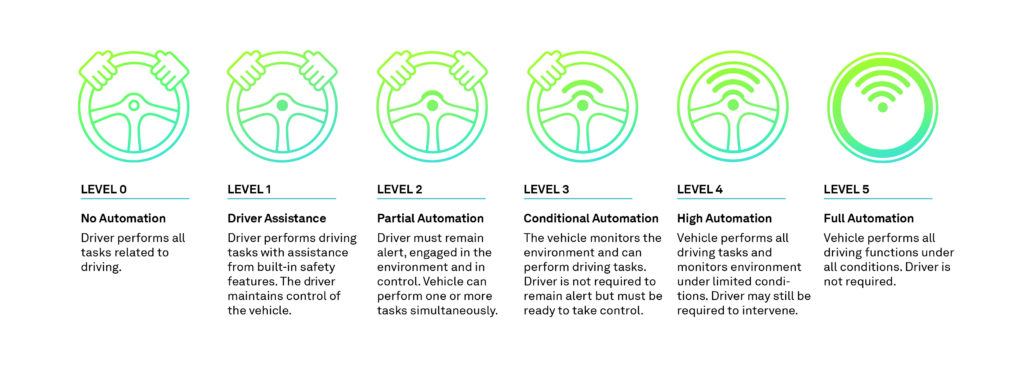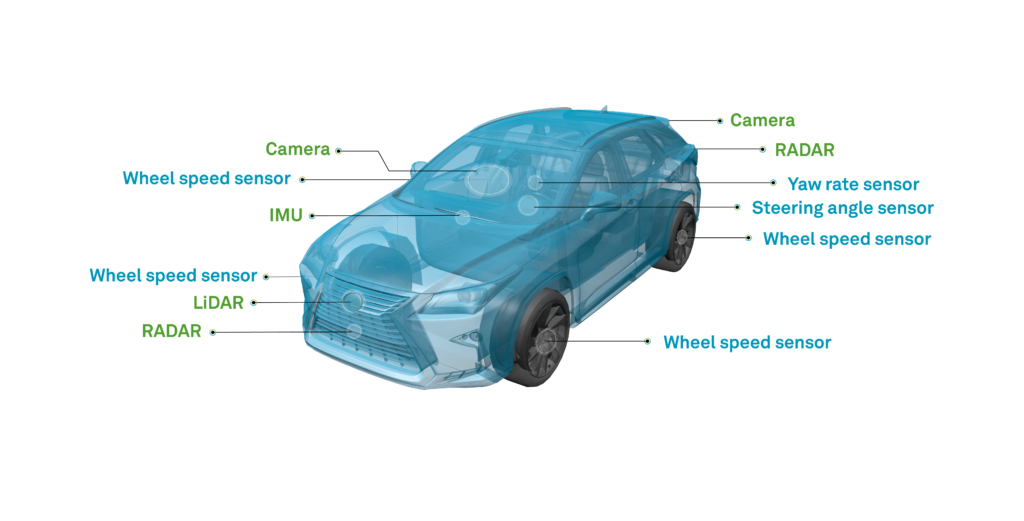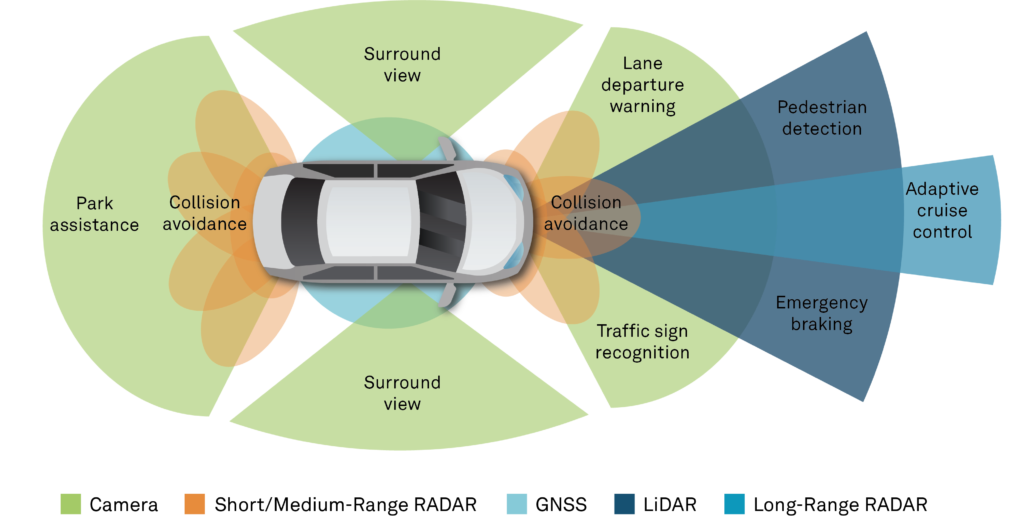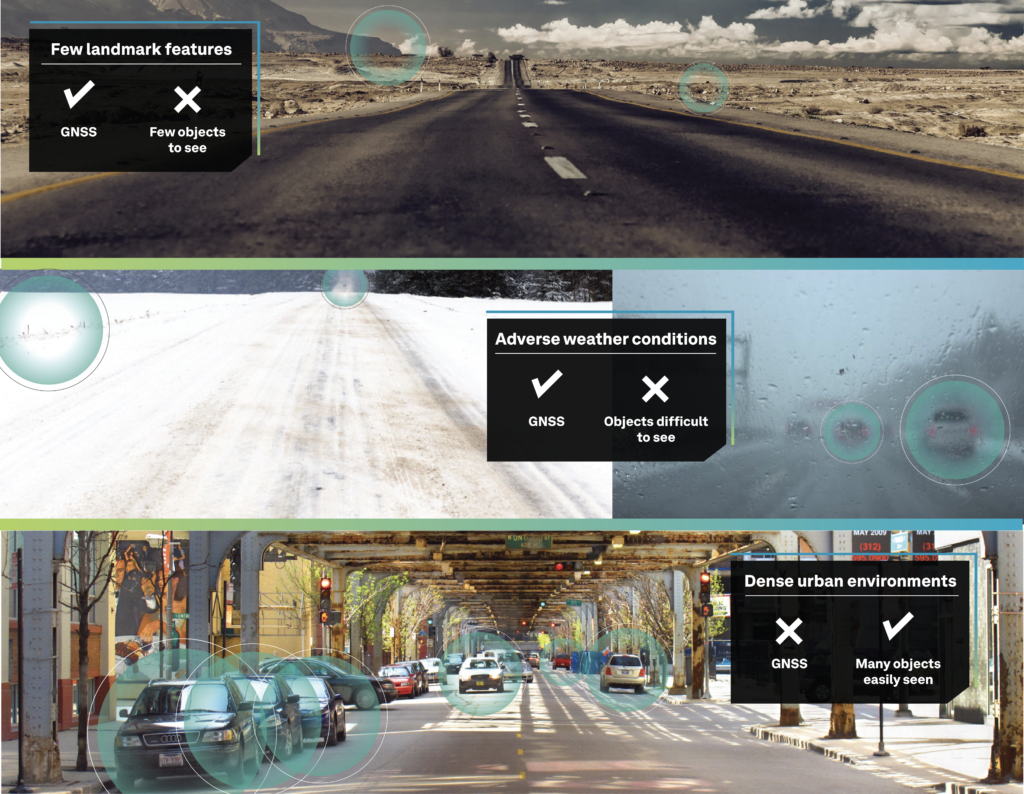
Safe, precise positioning technologies for the automotive industry


As the automotive industry moves to higher levels of automated and autonomous driving (Figure 1), lane-level accuracy combined with adherence to strict automotive safety standards is required, but what does it take to achieve both?
The combination of bringing safe, precise positioning to the automotive industry is what the engineers in Hexagon’s Safety Critical Systems group have been working toward. Leveraging decades of experience in high-precision positioning for vital industries such as defence, agriculture and marine, as well as being pioneers in safety-critical positioning for commercial aviation provides the perfect breeding ground for innovation to achieve automotive autonomy.
This article looks at the automotive positioning technologies that enable advanced driver-assistance systems (ADAS) and autonomous driving (AD) and how they work together to provide accurate, available and reliable positioning.
Positioning technologies for ADAS and AD
Most new vehicles come with safety features like blind spot and lane departure warnings and adaptive—or even hands-free—cruise control. These automated features, or ADAS, enhance vehicle safety. The goal of AD, where the car takes more control from the driver, is to further increase road safety.

Relative and absolute positioning technologies
ADAS and AD rely on information about the vehicle’s position and surroundings from multiple sources (Figure 2 and 3). These include visual sensors, such as cameras, RADAR and LiDAR, inertial navigation systems (INS) and other vehicle sensors that provide relative positioning. Onboard satellite positioning systems provide absolute positioning using global navigation satellite systems (GNSS).


To enable safe ADAS and AD in all conditions and environments, both relative and absolute positioning are needed, as they complement each other’s pros and cons (Figure 4). For example, visual sensors work well in clear conditions with enough objects to provide relative positioning; however, they struggle with obstructions to vision, like dirt, rain mist, snow, fog, poor lighting and areas with few objects.
On the other hand, GNSS positioning also has limitations. Because it relies on a line of sight between the receiver and the satellites transmitting the signals, it is affected by obstructions that disrupt transmission, such as tunnels, tall buildings or even a tree canopy.
When a vehicle has line-of-sight to the sky, GNSS provide accurate, reliable absolute positioning—even in adverse weather or in areas with few objects. Conversely, when a vehicle is unable to receive GNSS signals due to obstructions, the INS, visual and vehicle sensors can take over with relative positioning until GNSS can be reacquired to provide accurate positioning.
In this way, these complementary positioning technologies enable safe automated and autonomous driving.

Criteria for automotive positioning technologies
ADAS and AD require very high precision positioning—much higher than existing automotive navigation guidance systems. Positioning technologies need to provide continuous, lane-level accuracy, particularly for higher levels of autonomy. The criteria required to meet this are defined by accuracy, availability, reliability and trustworthiness, the latter relating to functional safety and integrity.
- Accuracy = Degree to which the position provided by a solution matches the true position.
- Availability = Percentage of the time that a solution can be used for positioning.
- Reliability = The culmination of a positioning solution’s availability at the required accuracy level.
- Functional safety = The absence of unreasonable risk due to hazards caused by malfunctioning behaviour of the positioning solution.
- Integrity = Degree to which the information provided by a positioning solution can be trusted.
To achieve these criteria, several advancements have been made in the components that make up automotive positioning systems, including multi-constellation, multi-frequency receivers, continuously available global corrections with built-in redundancies and integrity monitoring, and advanced sensor fusion and precise positioning algorithms that combine GNSS with other sensor information.
Beyond corrections integrity monitoring, receiver autonomous integrity monitoring (RAIM) is a receiver algorithm that assesses the integrity of individual GNSS signals. Originally developed for aviation, RAIM algorithms are being modified by Hexagon and applied to the automotive use case.
Ultimately, all automotive technologies used for safety-critical applications such as ADAS and AD must meet International Organization for Standardization (ISO) functional safety standards and requirements to achieve a given Automotive Safety Integrity Level (ASIL).
Visit our Automotive Solutions webpages to learn more about how Hexagon is bringing precise, safe positioning to the automotive industry.
About Hexagon
Hexagon is the global leader in precision technologies at any scale. Our digital twins, robotics and AI solutions are transforming the industries that shape our reality. Hexagon’s Autonomy & Positioning division is a global technology leader, pioneering end-to-end solutions for assured positioning for land, sea and air. Its solutions power intelligent positioning ecosystems in vital industries and safety-of-life applications, enabling the advancement of autonomy (cars, UAVs, industrial vehicles, trains, vessels and more). The division includes leading brands NovAtel, Veripos and AutonomouStuff.
Hexagon │ NovAtel has been developing high-precision satellite positioning technology for over 30 years—since the first days GPS satellites were launched. We have a long track record of being first in several innovative technologies for satellite positioning, including the development of safe positioning for the aviation industry. Now we are making satellite positioning not only precise but safe for the automotive industry.
This page was produced by North Coast Media’s content marketing staff in collaboration with Hexagon. NCM Content Marketing connects marketers to audiences and delivers industry trends, business tips and product information. The GPS World editorial staff did not create this content.









